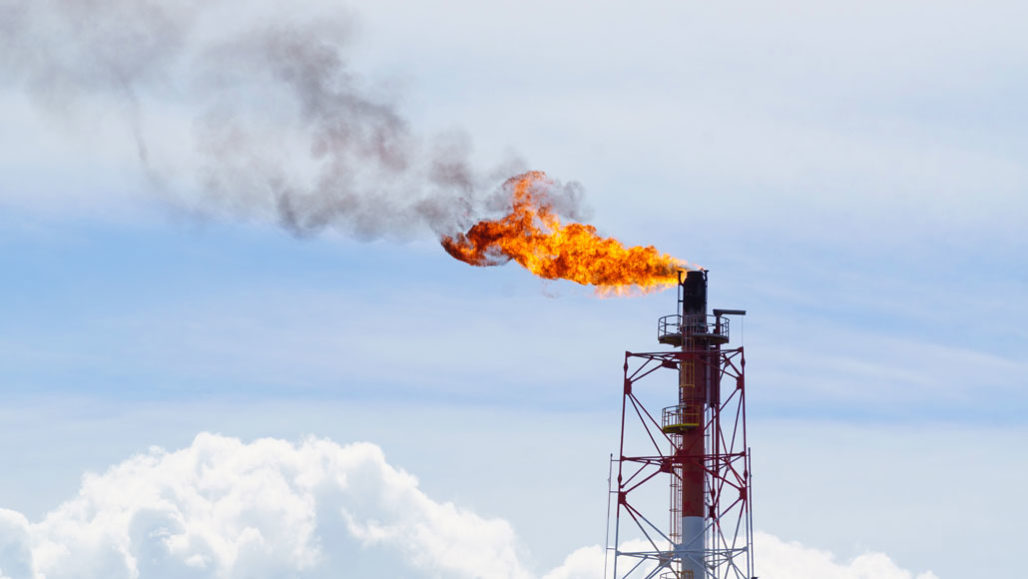Fossil fuels appear to release far more methane than we thought
Ice-core measurements suggest most of today’s methane releases are due to human activities

Oil and natural gas plants burn off some methane with “flaring,” as seen here. Gas also escapes into the air via leaky pipes and venting. A new study suggests that methane emissions from fossil fuels have been way underestimated.
Lanolan/ iStock/Getty Images Plus
Using fossil fuels releases far more methane — a potent greenhouse gas — than people had thought. Possibly 25 to 40 percent more, new research suggests. The finding could help point toward ways to reduce these climate-warming emissions.
Like carbon dioxide, methane is a greenhouse gas. But the impacts of these gases are not the same. Methane warms the atmosphere more than CO2 does. Yet it stays around for only 10 to 20 years. CO2 can linger for hundreds of years. “So the changes we make to our [methane] emissions are going to impact the atmosphere much more quickly,” says Benjamin Hmiel. He’s an atmospheric chemist at the University of Rochester in New York. He worked on the new study.
In the 1900s, coal mining, natural gas and other fossil fuel sources raised methane levels in the atmosphere. Those emissions fell early in this century. However, beginning in 2007, methane began to rise once again. It’s now at a level not seen since the 1980s.
What’s causing the latest buildup isn’t clear. Previous research had pointed to microbial activity in wetlands. That could be linked to changes in temperature and rainfall. Other sources might include more cow burps and leaky pipelines. Less methane also may be breaking down in the atmosphere.
If methane emissions keep rising, meeting global goals to lower greenhouse gases will be hard, says Euan Nisbet. He’s a geochemist who did not take part in this study. He works in England at Royal Holloway, University of London. Identifying how much methane the oil and gas industry releases could help target reductions, he says.
A teragram is equal to 1.1 billion short tons. Sources from the ground, also known as geologic sources, emit from 172 to 195 teragrams of methane each year. Those sources include releases due to oil and gas production. They also include such sources as natural-gas seeps. Researchers had estimated that the natural sources released from 40 to 60 teragrams of methane each year. They thought the rest came from fossil fuels.
But new studies of ice cores suggest that natural seeps release far less methane than people had thought. That means people today are responsible for nearly all the methane in our atmosphere, Hmiel says. He and his colleagues reported their findings February 19 in Nature.

Educators and Parents, Sign Up for The Cheat Sheet
Weekly updates to help you use Science News Explores in the learning environment
Thank you for signing up!
There was a problem signing you up.
Measuring methane
To really understand the role of human activities in methane releases, researchers need to look to the past. In the new study, Hmiel’s team turned to methane preserved in ice cores. Found in Greenland, those cores dated from 1750 to 2013.
That earlier date is right before the Industrial Revolution began. It was shortly after that people began burning fossil fuels in large amounts. Before that time, methane emissions from geologic sources averaged about 1.6 teragrams per year. The highest levels were no more than 5.4 teragrams per year.
That’s much smaller than previous estimates. The researchers now conclude that nearly all of the nonbiological methane released today (cow burps are a biological source) comes from human activities. That’s an increase of 25 to 40 percent over previous estimates.
“That’s actually a hopeful finding,” says Nisbet. It’s fairly easy to stop gas leaks and reduce coal-mine emissions, he says. So reducing these methane emissions offers “an even bigger opportunity” for cutting greenhouse gases.
But such ice-core analyses may not be the most accurate way to estimate natural emissions, argues Stefan Schwietzke. He’s an environmental scientist. He works at the Environmental Defense Fund in Berlin, Germany. Ice cores give a snapshot of global methane releases. But, he adds, interpreting those ice cores can be hard and requires “a lot of very complex analysis.”
Direct measurements of methane from seeps or mud volcanoes suggest much larger natural emissions, he adds. This method, however, is hard to scale up to give a global estimate.
Schwietzke and other scientists have proposed scouting for methane releases from the air. Scientists have already been using this method to identify methane leaking from pipelines, landfills or dairy farms. Similar projects are tracking hot spots in Arctic permafrost.
This technique can identify local hot spots. Adding then up can help build a big-picture estimate.
Still, Schwietzke adds, this debate over technique doesn’t change the main point. People are responsible for the dramatic rise of atmospheric methane over the last century. “It is very large,” he notes. “And reducing those emissions will reduce warming.”







